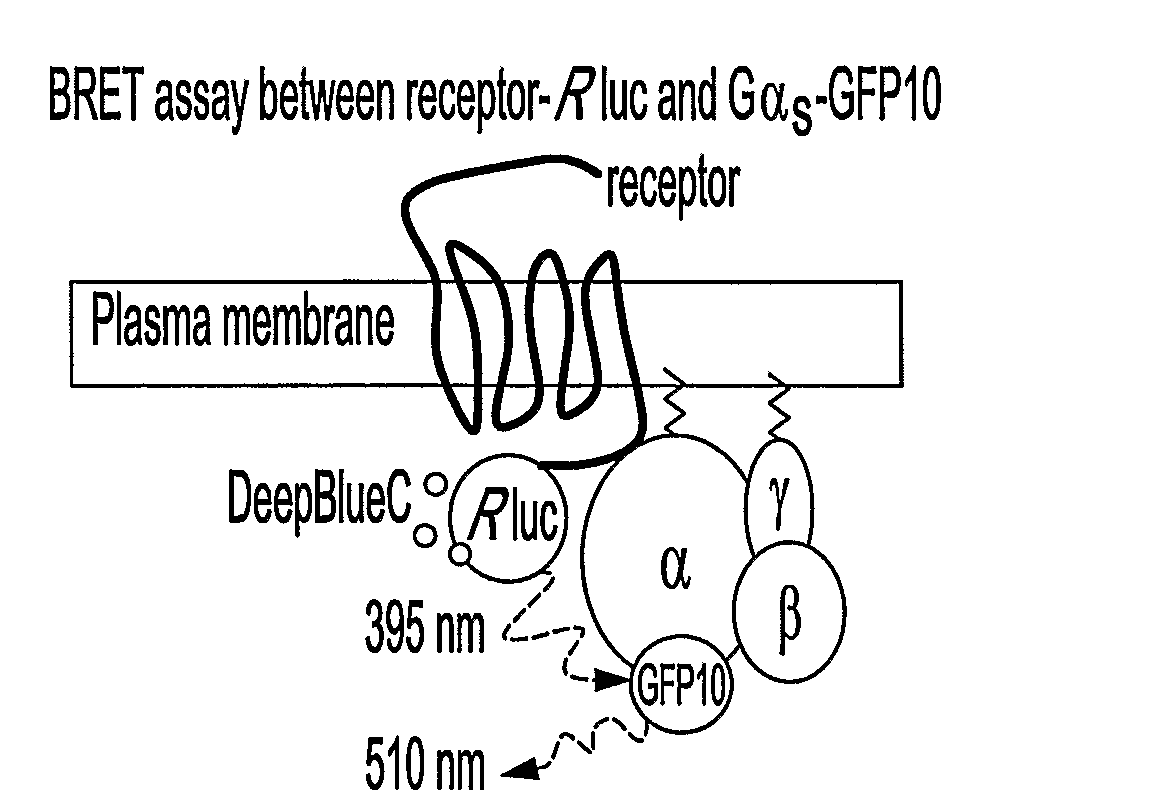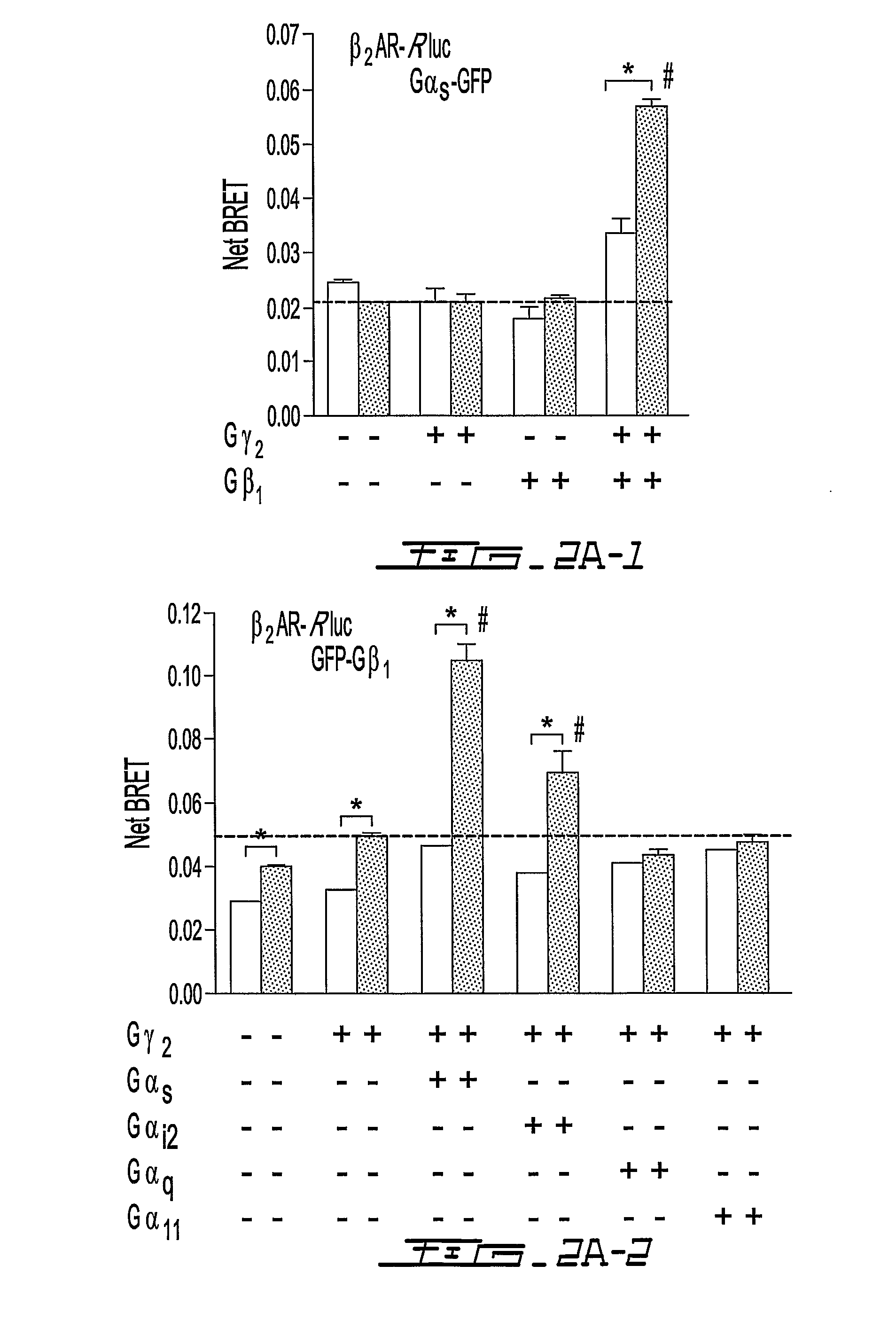Biosensors for monitoring receptor-mediated g-protein activation
a biosensor and receptor technology, applied in the field of biosensors, can solve the problems of largely in vitro studies deduced from classical collision models, unable to direct assess the real-time interactions between receptors and g proteins in living cells, and the general acceptance of collision-based models
- Summary
- Abstract
- Description
- Claims
- Application Information
AI Technical Summary
Benefits of technology
Problems solved by technology
Method used
Image
Examples
example 1
Configuration of the BRET Partners Used to Monitor Receptor-Mediated G Protein Activation
[0112]To monitor the interactions between GPCRs and their cognate G proteins and among the G proteins subunits, BRET1 and BRET2 signals were measured between the different partners in living cells in the presence and absence of selective receptor ligands. Receptors, Gαi1, Gβ1 and Gγ2 were fused to BRET energy donor or acceptor (FIG. 15a). The receptors (α2AR, β2AR and CRLR) were fused at their carboxyl tail to the Renilla reniformis luciferase (Rluc) or Aequorea victoria green fluorescent proteins (GFP2, GFP10 or YFP, depending on the partners considered). Gβ1 and Gγ2 were fused to their N-terminus to either Rluc or GFP10. For Gαi1, two different constructs were engineered so as to allow a better monitoring of the relative movements of the partners. Rluc was inserted in connecting loops located at opposite sides within the helical domain of the protein (FIG. 15b). One of the insertion site betwe...
example 2
Receptor-Ligand Binding Promotes Conformational Rearrangement within Receptor / G Protein Complexes
[0115]BRET2 was monitored between the human α2A-adrenergic receptor (α2AAR-Rluc or α2AR-GFP2) and each of the G protein subunits (GFP10-Gβ1; GFP10-Gγ2; Gαi1-91Rluc or Gαi1-122Rluc). As shown in FIG. 20, a basal BRET signal was detected in all cases, indicative of a constitutive receptor-Gαβγ complex that may reflect pre-association8. The specificity of this interaction, was confirmed by the observation that no significant signal was detected between a form of the transmembrane protein CD8 fused to Rluc or GFP2 at its C-terminus8 and any of the GFP2 or Rluc tagged-G protein subunits (data not shown). Stimulation of the receptor with the full agonist, UK14,304, significantly increased the BRET detected for the α2AAR-Rluc / GFP10-Gβ1, α2AAR-Rluc / GFP10-Gγ2 and Gαi1-91Rluc / α2AAR-GFP2 pairs (FIG. 20a). In contrast, the BRET was significantly reduced by the agonist stimulation for the Gαi1-Rluc12...
example 3
Ligand-Promoted Conformational Changes within Preformed Receptor / Gαβγ Complexes
[0119]The following experiments were designed to determine whether the agonist-promoted structural reorganization of the receptor / G protein complex occurred as a result of an active recruitment of the G proteins to the receptor. Since an active recruitment presupposes that agonist stimulation increases the affinity of the receptor for the G protein subunits, BRET titration assays between α2AAR-Rluc and GFP10-Gβ1 or GFP10-Gγ2 and between Gαi1-91Rluc or Gαi1-122Rluc and α2AAR-GFP2 were carried out in the presence and absence of UK14,304. BRET50 (the GFP / Rluc ratio leading to 50% of the maximal BRET signal) derived from such titration curves is used as relative indicator of the affinity between partners23, 24.
[0120]As shown in FIG. 26a, agonist treatment led to an increase (α2AAR-Rluc / GFP10-Gβ1, / GFP10-Gγ2 or Gαi1-91Rluc / α2AAR-GFP2) or a decrease (Gαi1-122Rluc / α2AAR-GFP2) of the maximal BRET but did not affe...
PUM
| Property | Measurement | Unit |
|---|---|---|
| emission peak | aaaaa | aaaaa |
| pH | aaaaa | aaaaa |
| energy | aaaaa | aaaaa |
Abstract
Description
Claims
Application Information
 Login to View More
Login to View More - R&D
- Intellectual Property
- Life Sciences
- Materials
- Tech Scout
- Unparalleled Data Quality
- Higher Quality Content
- 60% Fewer Hallucinations
Browse by: Latest US Patents, China's latest patents, Technical Efficacy Thesaurus, Application Domain, Technology Topic, Popular Technical Reports.
© 2025 PatSnap. All rights reserved.Legal|Privacy policy|Modern Slavery Act Transparency Statement|Sitemap|About US| Contact US: help@patsnap.com



